How to Write Email
Insider Tips to Write Engaging Networking Emails
Learn the secrets to crafting a networking email that leaves a lasting impression and opens doors to new opportunities.

Are you eager to learn how to create a networking email that truly stands out? Let me assure you, it involves more than just quickly firing off an email and crossing your fingers.
There's a real art to it, and it takes some careful thought and planning. But don't worry, we've got you covered.
Stick with us, and we'll show you the ins and outs of writing a networking email that will make a lasting impression.
Key Takeaways
- Personalization is crucial in networking emails to grab attention and engage the recipient.
- Clearly state the purpose of the email and what you hope to achieve.
- Maintain a polite and professional tone throughout the email.
- Proofread for errors to ensure a professional impression.
Crafting a Compelling Networking Email
Crafting a compelling networking email requires a personalized and professional approach to effectively engage with the recipient. When we're reaching out to someone, it's crucial to do our homework. We need to find out about the person we're emailing, their role, and any recent work or achievements. This allows us to personalize the email, making it more relevant and engaging.
A compelling networking email starts with a subject line that grabs attention without being clickbait. We want to pique the recipient's interest, not mislead them.
Keeping the body of the email concise and to the point is essential. Nobody has time for lengthy, rambling emails. It's important to strike a balance between professionalism and personalization. We want to come across as polite and respectful while also showing that we've put in the effort to tailor the email to the recipient.
By following these guidelines, we can craft compelling networking emails that work.
If you love this article, forward it to your colleagues who could benefit from these tips.
Essential Components of a Networking Email
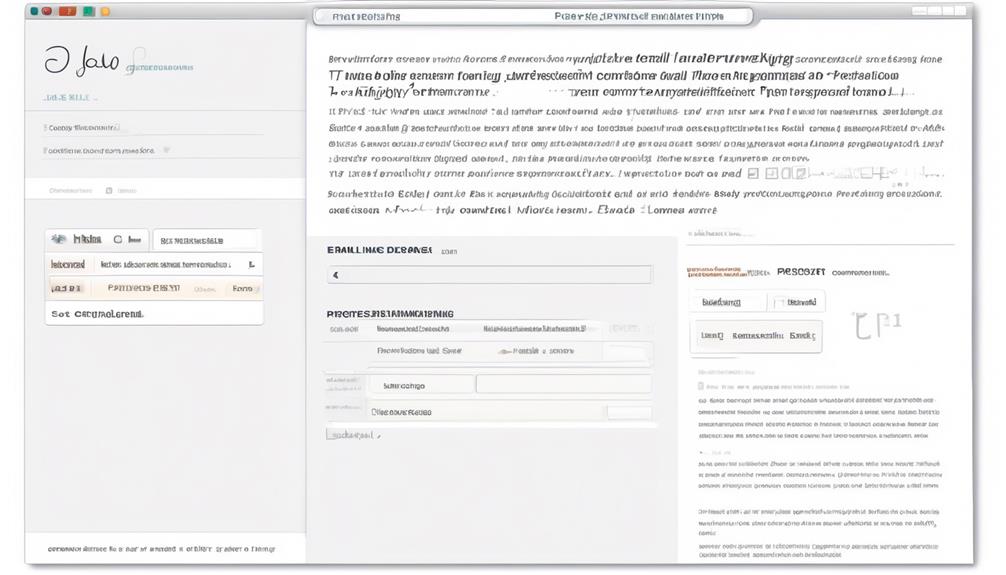
When networking via email, personalizing the message to align with the recipient's interests and needs is crucial for establishing a meaningful connection. It is important to know your audience and tailor the email to resonate with them. Here are the essential components of a networking email:
| Personalization | Clearly Stated Purpose | Polite and Professional Tone | Proofreading |
|---|---|---|---|
| Tailor the email to the recipient's interests and needs | Clearly state the purpose of the email and what you hope to achieve | Maintain a polite and professional tone throughout the email | Proofread for any grammatical or spelling errors |
In addition to these components, using effective subject lines, providing a call to action, and following up if no response is received are also crucial. Utilizing email templates can be beneficial, but it's important to customize them for each recipient. Whether it's for sending a networking email to someone you admire or to request an informational interview, these components are essential for writing an effective networking email. Good networking emails can lead to valuable connections and opportunities.
Tips for Writing Effective Networking Emails
To further enhance the effectiveness of networking emails, it's imperative to implement specific strategies that can significantly elevate the impact of our communication.
The email subject plays a crucial role in grabbing the recipient's attention, so make sure it's personalized and relevant.
When crafting the email, it's essential to research the recipient and tailor the content to their interests or experiences, making it engaging and meaningful. In the body of the email, clearly state the purpose and what you hope to achieve, maintaining a polite and professional tone throughout.
I'd love to hear your valuable insight on this subject and I'm looking forward to building a mutually beneficial professional relationship.
Additionally, incorporating a bit of small talk can help in establishing rapport.
Always proofread for any errors before hitting send, as these can detract from the professionalism of the email.
Sample Networking Email Templates
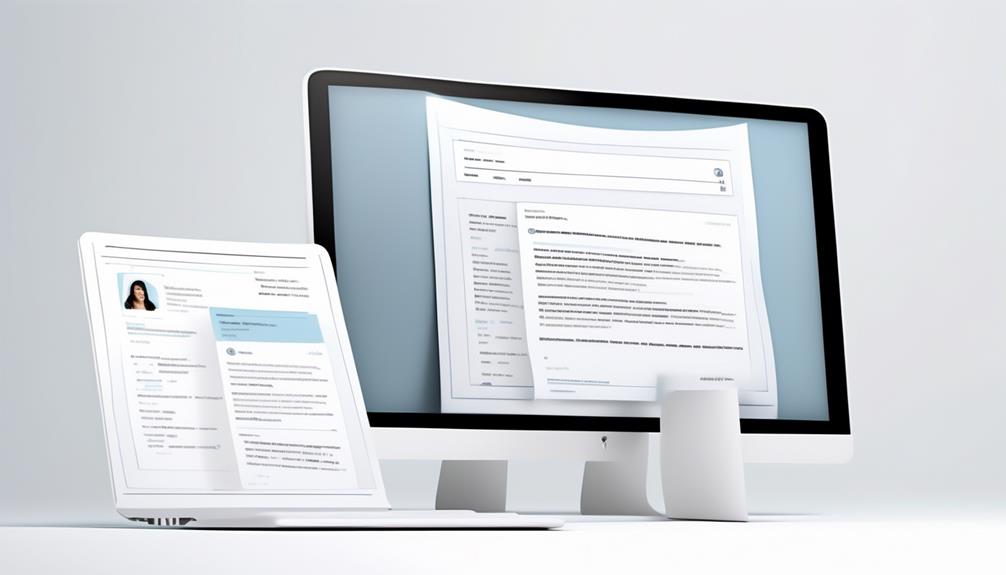
Implementing effective networking email templates can significantly streamline the communication process and improve response rates. When reaching out to make new connections, it's important to personalize your message and show genuine interest in the recipient.
Here are a few sample networking email templates to help you get started:
- Connecting Over Shared Interests:
Subject: Exploring Common Ground
Hi [Name],
I recently came across your work in digital marketing and was impressed by your recent article on [topic]. I'd love to connect and discuss our shared professional interests. Perhaps we could grab a coffee sometime next week?
Looking forward to hearing from you,
[Your Name]
- Requesting a Phone Call:
Subject: Insightful Conversation
Hello [Name],
I'm familiar with your work in digital marketing and would appreciate the opportunity to have a brief phone call to learn more about your experiences and insights in the industry. Are you available for a quick call sometime this week?
Best regards,
[Your Name]
Feel free to customize these templates based on your specific networking goals and the nature of your professional relationship with the recipient.
Common Mistakes to Avoid in Networking Emails
Avoiding common mistakes in networking emails is essential for making a positive and professional impression on your contacts. One common mistake is being too generic. Personalization is key in networking emails, so avoid using generic templates and make sure to address the recipient by name.
Another mistake is being too vague about the purpose of the email. Clearly state why you're reaching out and what you hope to achieve, whether it's seeking advice, setting up a meeting, or expressing interest in a job opportunity.
Additionally, avoid being too informal or too formal. Find the right balance based on your relationship with the recipient and the context of the email.
Furthermore, overlooking typos and grammatical errors can make you appear careless and unprofessional. Always proofread your email before hitting send.
Lastly, avoid being too self-centered. Instead of focusing solely on your own needs, show genuine interest in the recipient by asking about their work, recent achievements, or offering to help them in some way.
What are the key components of a well-written networking email?
When writing effective networking emails, it’s crucial to include a clear subject line, personalized greeting, and a concise but informative body. Make sure to highlight the value you can offer and always end with a polite call to action. Remember, a well-written networking email can pave the way for successful connections.
Frequently Asked Questions
How Do I Write a Networking Email?
We write a networking email by crafting a clear and concise message that highlights our value and purpose for reaching out.
We establish a connection, show genuine interest, and offer something of value.
It's important to personalize the email, keep it professional, and end with a clear call to action.
Remember to proofread and follow up if needed.
These steps will help us create effective networking emails that yield positive results.
How Do You Write a Cold Call Email for Networking?
When writing a cold call email for networking, we aim to make a strong first impression.
We should personalize the email to the recipient and clearly state our purpose for reaching out.
It's crucial to convey our value and how we can benefit the recipient.
A concise and engaging email will capture their attention and increase the likelihood of a positive response.
How Do I Reach Out to Someone I Networked With?
We reach out to someone we networked with by referencing our initial interaction.
We express gratitude for the opportunity to connect and our interest in continuing the relationship.
We should be clear about our intention for reaching out.
We offer something of value in return.
We clearly state our next steps.
It's important to be concise and respectful of their time.
We aim to foster a mutually beneficial connection and set the stage for further collaboration.
How Do I Write a Linkedin Email for Networking?
We write a LinkedIn email for networking by personalizing the message to the recipient, using a compelling subject line, and maintaining a professional tone.
We clearly state the purpose and what we hope to achieve, ensuring relevance to the recipient.
Researching the recipient beforehand is vital.
This approach helps us craft a tailored and effective networking email that stands out and encourages a positive response.
Conclusion
In conclusion, crafting an effective networking email requires careful research, personalization, and a professional tone.
By highlighting similarities, praising the recipient, and clearly stating the purpose, one can increase the likelihood of a positive response.
Remember to follow up if necessary and avoid common mistakes such as being too lengthy or informal.
With these tips in mind, your networking emails are sure to make a lasting impression.
Natali – Editor in Chief (Strategy and Mastery, AI Expert) Natali, our Editor in Chief, is the driving force behind our content’s strategic direction. With a keen eye for detail and a deep understanding of market trends, Natali ensures that our content is top-notch and strategically aligned with our client’s goals. Her expertise in AI helps to seamlessly integrate advanced technology into our marketing strategies, pushing the boundaries of conventional marketing.
How to Write Email
Vacation Email Etiquette: How to Write with Politeness
Struggling to craft the perfect vacation email? You'll want to keep reading for essential tips and strategies to nail it.

So, we’re all familiar with the routine of composing a professional out-of-office email, correct? Actually, perhaps not.
While the idea of taking time off sounds like a breeze, the art of communicating that to your colleagues can be a bit more complex.
But fear not, because we've got some key tips and strategies to help you navigate the ins and outs of drafting the perfect out-of-office message.
Whether it's setting clear expectations or ensuring your absence won't disrupt the team's workflow, there's a lot to consider when it comes to mastering the art of the vacation email.
Key Takeaways
- Include specific details such as dates of absence, expected return date, and urgent instructions in the vacation email.
- Clearly communicate dates of absence in the out-of-office message and provide alternative contacts for urgent matters.
- Maintain a professional tone in all communication and convey professionalism and reliability in the out-of-office message.
- Understand company vacation policy and use appropriate request email templates, while also considering the impact on workload and showing consideration for the team when requesting time off.
Essential Components of a Vacation Email
When crafting a vacation email, it's essential to include specific details such as the dates of your absence, your expected return date, and any necessary instructions for urgent matters. A concise subject line should indicate that it's an informal vacation request. In the body of the email, maintain a professional tone to ensure a smooth and clear communication process.
In the first paragraph, clearly state the purpose of the email – to request vacation time. Provide the dates of your absence, including the start and end dates, and your expected return date. This information helps the recipient understand the duration of your absence and plan accordingly.
Additionally, if there are any specific instructions for urgent matters during your absence, make sure to include them in the email to ensure that any critical issues can be addressed in your absence.
Crafting a Professional Out-of-Office Message
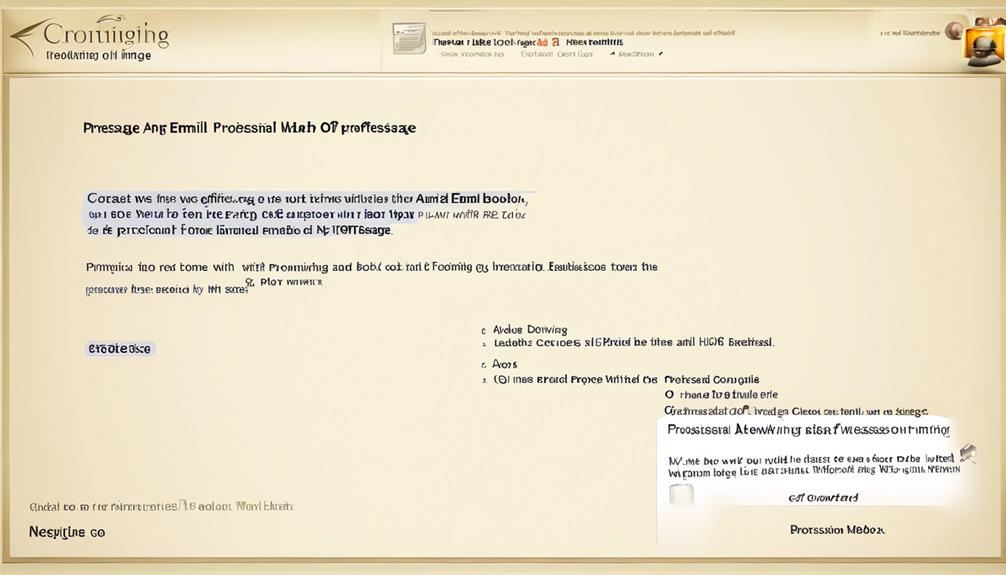
After requesting vacation time, it's important to also craft a professional out-of-office message that clearly communicates the dates of absence and provides alternative contacts for urgent matters.
When writing the out-of-office message, it's essential to ensure that it conveys a sense of professionalism and reliability. Clearly state the dates of your absence and provide an alternative contact in case of urgent matters.
It's good practice to express gratitude for understanding and cooperation during your leave. Additionally, offer to follow up on any pending matters upon your return to reassure colleagues and clients that their issues will be addressed promptly.
While crafting the message, it's important to adhere to company communication standards and policies to maintain consistency in tone and content. Avoid sharing unnecessary personal details in the out-of-office message to maintain a professional tone.
Writing a good out-of-office message is crucial as it reflects your commitment to professionalism and ensures that important matters are attended to in your absence.
Setting Expectations With Colleagues and Clients
To ensure smooth communication during my absence, we will clearly communicate our availability and response times for emails and calls to colleagues and clients. It's crucial to set realistic expectations and maintain a professional tone in all communication. Here is a simple table to help you craft a professional email and set expectations with your colleagues and clients:
| Information to Include | Example |
|---|---|
| Availability during vacation | I will be out of the office from [start date] to [end date]. |
| Response times for emails and calls | I will have limited access to emails and will respond within 24-48 hours. |
| Delegated responsibilities | Please contact [colleague's name] for any urgent matters. |
| Contact information | For immediate assistance, please reach out to [colleague's name] at [contact information]. |
Effective Examples of Out-of-Office Messages
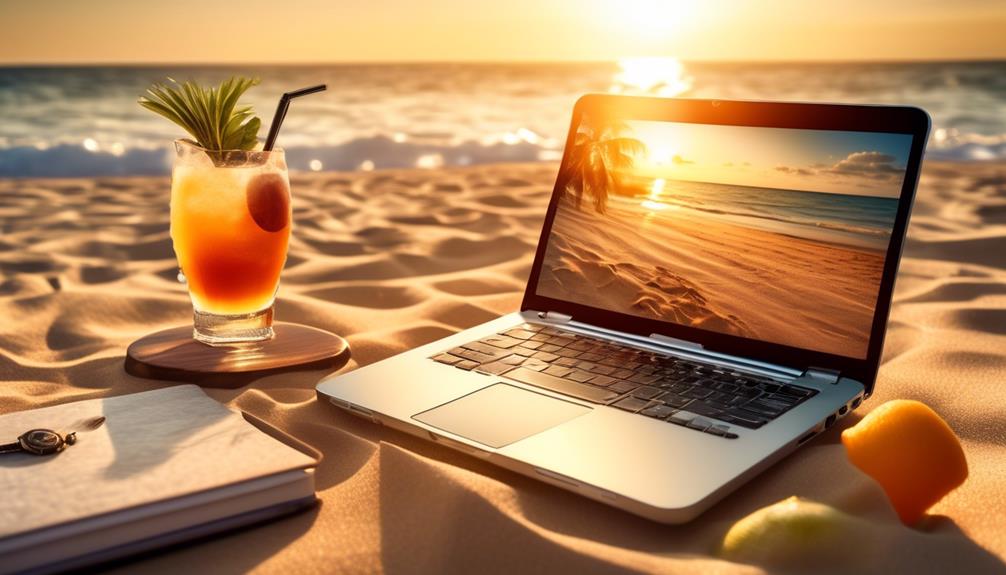
Crafting effective out-of-office messages is an essential aspect of maintaining clear communication while on vacation. When writing these messages, it's important to be polite and professional while providing the necessary information. Here are three effective examples of out-of-office messages that you can use as a template for your own:
- 'I am currently out of the office and will return on [date]. For urgent matters, please contact [colleague's name] at [colleague's email].'
- 'Thank you for your email. I'm out of the office until [date] and will have limited access to email. For immediate assistance, please contact [alternative contact].'
- 'I am on vacation until [date] and won't be checking emails. For urgent matters, please reach out to [colleague's name] at [colleague's email].'
These examples demonstrate a good rule of thumb for crafting effective out-of-office messages. They provide clear information about the duration of the absence, alternative contacts for urgent matters, and set professional expectations for communication while away.
When using these examples, be sure to customize them to fit your specific situation and maintain a polite and professional tone.
Mastering the Art of the Vacation Email
As we focus on mastering the art of the vacation email, it's essential to seamlessly shift from crafting effective out-of-office messages to the nuances of requesting and composing a professional vacation email.
When it comes to requesting time off, knowing how to write a Vacation Leave Request or Time Off Email is crucial. We need to make sure we understand the company vacation policy and use the appropriate request email template. It's important to know the steps for writing a vacation request email, including a concise subject line, specifying the reason for the request, exact dates, preparation steps, and a thank-you note. Additionally, we should ask ourselves if we really need to take those days off, consider the impact on our workload, and reflect consideration for our team.
Understanding different types of vacation request emails, such as reminders, emergency time off, annual vacations, one day off, or canceling a vacation request, is also essential. Before sending a vacation request email, we need to ensure we include emergency contact information if necessary and assure coverage during our absence.
Mastering the art of the vacation email requires attention to detail and adherence to professional etiquette.
Frequently Asked Questions
What Should I Write in a Vacation Email?
We should include the dates of our absence, the reason for our vacation, and who to contact in our absence.
It's important to keep the email brief and to the point, while also expressing gratitude for understanding.
We can reassure the recipient that we'll respond to any urgent matters upon our return.
It's also good to set up an out-of-office auto-reply with the same information.
How Do You Write an Email for Time Off?
We write an email for time off by crafting a clear subject line, stating the purpose, providing specific dates, and outlining a plan for managing responsibilities during absence.
We ensure to include emergency contact information and express willingness to address any concerns. Politeness, professionalism, and appreciation are crucial throughout.
Understanding company policies and considering workload impact on colleagues help in crafting a thoughtful request reflecting consideration for the team.
How Do You Email a Planned Vacation Leave?
When we email a planned vacation leave, it's important to be clear and concise about the dates and reason for our absence. We should also mention who'll be covering for us in our absence and provide any necessary contact information.
It's crucial to ensure that our email is professional and respectful of our colleagues' time and responsibilities. Lastly, we should make sure to set up an out-of-office auto-reply for any incoming emails during our vacation.
How Do I Professionally Say I Am on Vacation?
We inform our colleagues of our vacation by clearly stating the purpose and dates.
We assure them that work will be handled and maintain a polite and professional tone.
We offer to address any concerns and end with a thank you note and openness to discussions.
This approach ensures a professional and considerate communication of our absence.
Conclusion
We understand that taking vacation time can sometimes feel like a burden on our colleagues. However, by following the proper procedures and communicating effectively, we can ensure a smooth transition and minimal disruption.
Our team's support for each other's well-deserved time off strengthens our bond and ultimately leads to a more productive and positive work environment.
Erik – Email, SEO, AI Expert Writer Erik is the strategist, the thinker, and the visionary. His role at Influenctor is pivotal in integrating SEO with AI-driven content strategies. With an extensive background in email marketing and a profound understanding of search engine algorithms, Erik develops innovative strategies that elevate our client’s online presence. His work ensures that our content is seen, felt, and remembered.
How to Write Email
How to Write a Polite RSVP Email
Discover the essential elements for crafting a compelling RSVP email that guarantees a timely and clear response.
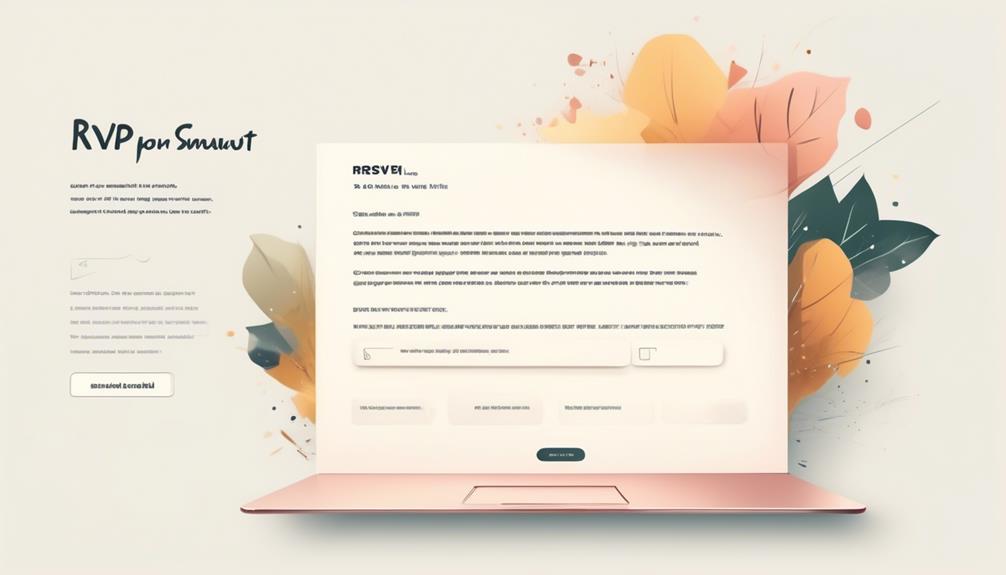
Crafting an RSVP email is akin to creating the ideal invite – each phrase and element reflects the event’s tone and professionalism. We’ve all gotten RSVP emails that puzzle us, leaving us unsure of how to reply or even what we’re replying to.
But fear not, because we've got the key to crafting an RSVP email that will guarantee a timely and clear response. So, whether you're planning a corporate event or a casual gathering, mastering the art of crafting a compelling RSVP email is crucial for ensuring a successful and organized event.
Key Takeaways
- The subject line of an RSVP email should be concise and informative.
- Respond promptly to RSVP emails and acknowledge the invitation with gratitude.
- Craft a professional RSVP email using polite language, proper grammar, and a respectful tone.
- Clearly explain the importance of RSVP, encourage confirmation and provide necessary details in the email.
Understanding the RSVP Email
Understanding the RSVP email is crucial for properly responding to event invitations and ensuring clear communication with the host. When crafting an RSVP email, it's essential to pay attention to the RSVP email subject to convey your response clearly. The subject line should be concise and informative, such as 'RSVP Confirmation for [Event Name]' or 'Reply to RSVP for [Event Date].' This helps the host easily identify and categorize responses.
In addition, it's important to respond to RSVP emails promptly. This not only shows respect for the host's invitation but also helps with event planning. When sending an RSVP via email, make sure to acknowledge the invitation, express gratitude, and provide a clear RSVP confirmation. Clearly state whether you'll attend or not, as well as any additional information requested, such as dietary preferences or the number of guests attending.
Crafting a professional RSVP email involves using polite language, proper grammar, and a respectful tone. The email should be concise, yet thorough, ensuring that all necessary details are included. Moreover, be mindful of any specific instructions provided in the invitation and address them in your response.
Crafting a Clear RSVP Request
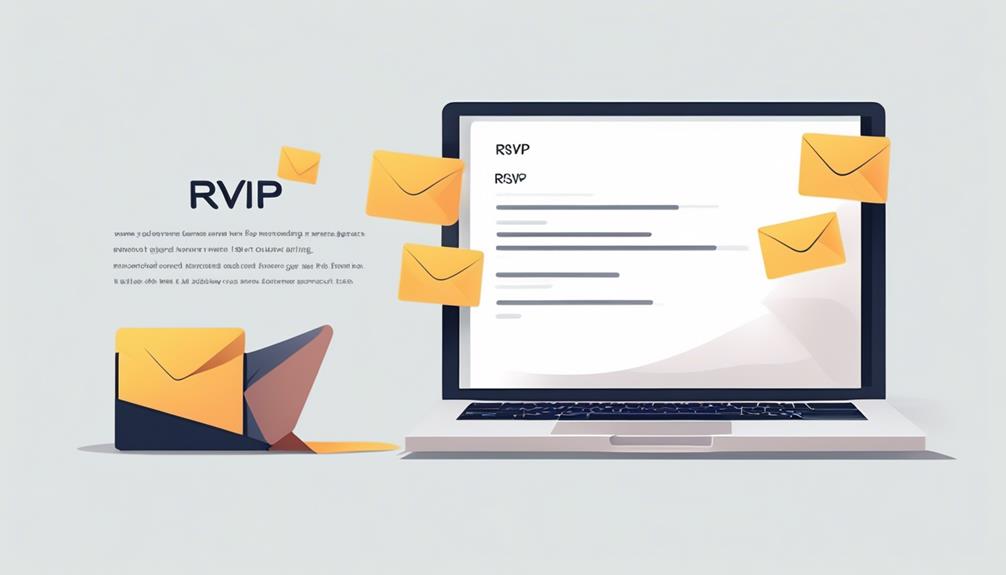
Upon receiving an event invitation, it's essential to clearly articulate the RSVP request, emphasizing the significance of timely responses and providing guidance on crafting a professional and courteous RSVP email.
When crafting a clear RSVP request, it's crucial to clearly explain what RSVP means and why it's important. Encourage recipients to let you know if they can attend and to confirm the exact number of attendees. Provide a standard RSVP format or template to make it easier for invitees to respond.
It's also important to offer RSVP samples or examples to guide recipients on how to write an RSVP email professionally. Emphasize the importance of prompt responses and encourage honesty and openness in their replies.
When making the RSVP request, be clear and direct in asking recipients to confirm their attendance. Use language that's polite and courteous, but also conveys the importance of their response.
Polite RSVP Email Closure
We appreciate the invitation and look forward to the event. It's important to conclude your RSVP email with a polite and friendly closure to leave a positive impression. Expressing gratitude for the invitation and conveying anticipation for the event is essential. Use phrases like 'Looking forward to the event,' 'Thank you for the invitation,' or 'Warm regards' to conclude your email respectfully. It's crucial to ensure that your closing aligns with the tone and formality of the event or the relationship with the host. Signing off with your name or a personalized closing, such as 'Best wishes' or 'Sincerely,' maintains professionalism. When replying, if you cannot attend, please let the host know. Here is an example of a polite RSVP email closure:
| Looking forward to the event | Thank you for the invitation | Warm regards |
|---|---|---|
| Excitement and anticipation | Gratitude | Friendliness |
Closing your RSVP email with warmth and appreciation leaves a lasting positive impression.
Utilizing RSVP Email Templates
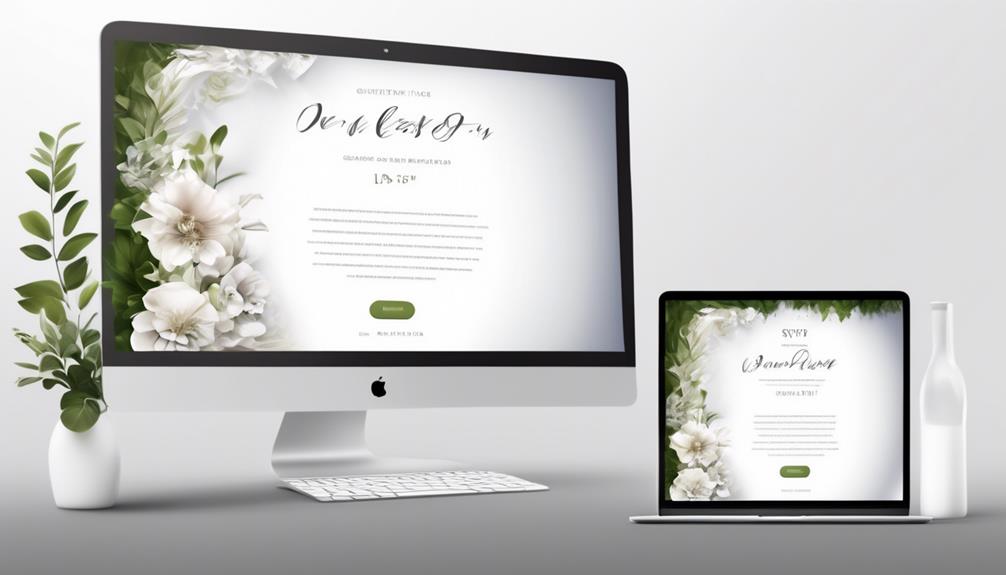
Utilizing email templates can greatly streamline the process of drafting RSVP responses, making the task more efficient and ensuring a consistent and professional tone. When writing invitation emails, using RSVP email templates can save time and effort, especially when responding to multiple invitations. These templates often include standard phrases such as 'Répondez s'il vous plaît,' 'We look forward to seeing you,' and 'Please kindly respond by [event date].' They can also provide guidance on how to address various RSVP responses, such as accepting, declining, or expressing gratitude for the invitation.
In addition to social events, RSVP emails are also crucial in professional settings, such as job applications, where prompt and well-crafted responses are essential. Utilizing templates can help maintain a polished and organized approach, which is particularly important for seating arrangements, dietary requirements, and other logistical considerations.
Mastering RSVP Response Etiquette
Mastering RSVP response etiquette involves understanding the significance of timely and respectful RSVP responses and adhering to established social and professional norms. When crafting an RSVP reply, it's crucial to strike the right tone, conveying your response clearly and professionally.
Whether you're unable to attend or excited to say yes, it's essential to communicate your decision promptly, allowing the host to make necessary arrangements. Politely declining an invitation requires tact and consideration, ensuring that the host understands your decision while expressing gratitude for the invitation.
In professional settings, such as event planning, mastering RSVP response etiquette is paramount for maintaining professional relationships and ensuring smooth coordination. Clear and concise language in RSVP messages is key, as it demonstrates respect for the host's time and effort in organizing the event.
Frequently Asked Questions
How Do You RSVP in an Email Example?
Sure, we can definitely help with that.
When responding to an email invitation, it's important to be polite and timely.
A simple 'Thank you for the invitation. We'll be attending the event' is a good example of how to RSVP in an email. It's concise and clearly conveys your response.
Remember to include all relevant details, such as the date and time of the event, and any plus-ones if applicable.
What Do You Write in a RSVP Response?
We always strive to provide a prompt and detailed response when sending an RSVP.
It's essential to express our gratitude for the invitation, state our intention to attend or regretfully decline, and include any necessary details requested.
Clear communication and a respectful tone are key in ensuring the event planner has the information needed for a successful gathering.
How Do You Confirm Rsvp?
We confirm RSVPs by sending a polite and prompt response to the invitation. It's important to acknowledge the invitation and clearly state our intention to attend or not.
A well-crafted email with a clear subject line and respectful tone can effectively confirm our RSVP. It's also essential to provide the requested response option, whether it's a 'Yes,' 'No,' or 'Maybe,' to ensure proper event planning and organization.
How Do You Politely Ask for Rsvp?
We kindly ask for your RSVP by the indicated date, as it will help us finalize the arrangements.
Your timely response is greatly appreciated.
Thank you for considering our invitation.
Conclusion
We've learned the importance of crafting a clear and engaging RSVP email.
Did you know that 80% of event planners say that receiving timely RSVPs is one of their biggest challenges?
By following the tips outlined and using a well-designed template, we can make the RSVP process smoother for both the host and the guests.
Happy RSVPing!
Erik – Email, SEO, AI Expert Writer Erik is the strategist, the thinker, and the visionary. His role at Influenctor is pivotal in integrating SEO with AI-driven content strategies. With an extensive background in email marketing and a profound understanding of search engine algorithms, Erik develops innovative strategies that elevate our client’s online presence. His work ensures that our content is seen, felt, and remembered.
How to Write Email
How to Write a Professional Email Reminder to Your Professor
Frustrated with unanswered emails? Learn how to craft a compelling reminder email to your professor for a prompt response.

We’ve all experienced it – a hectic week filled with numerous tasks, and then suddenly, the project deadline is just around the corner. You find yourself in need of some essential details from your professor, yet there’s been no reply to your first email.
Crafting a reminder email to your professor can be a delicate task, requiring a balance of assertiveness and respect. It's essential to consider the best approach to ensure your message stands out without coming across as pushy or demanding.
So, how do you strike that balance and ensure your reminder email gets the attention it deserves? Well, let's explore some effective strategies to master the art of writing a reminder email to your professor.
Key Takeaways
- Clearly explain the reason for the follow-up
- Reiterate the importance of the matter
- Express gratitude for the professor's time and attention
- Reflect positively on the sender
Understanding the Purpose
Understanding the purpose of writing a reminder email to a professor is essential for effectively communicating your needs and showing respect for their time. When crafting a polite follow-up email to a professor, it's important to ensure that the email serves as a gentle reminder rather than an imposition.
The original email likely mentioned getting in touch for a specific reason, and a polite follow-up can help speed the process along. It's important to clearly explain the reason for the follow-up, reiterating the importance of the matter and expressing gratitude for the professor's time and attention.
In writing a reminder email to a professor, the key is to be respectful and considerate. It's crucial to avoid sounding demanding or entitled and instead, convey a tone of appreciation and understanding. By doing so, the email not only serves its purpose of gently reminding the professor but also reflects positively on the sender.
Understanding the purpose of the email and approaching it with a polite and respectful tone is fundamental in effectively communicating with professors.
Setting the Right Tone

When composing a reminder email to a professor, it's crucial to set a respectful and professional tone that aligns with the formality of the professor's communication style. This ensures that the email conveys courtesy and appreciation for the professor's time and expertise.
To achieve this, consider the following:
- Be courteous and polite: Express gratitude for the professor's guidance or feedback in your email.
- Use respectful language: Address the professor using their appropriate title and maintain a formal tone throughout the email.
- Show consideration for the professor's time: Keep the email concise and to the point, demonstrating that you value their time.
- Convey enthusiasm and eagerness: Express your genuine interest in receiving feedback or a reminder of your request, showcasing your dedication to the subject matter.
Structuring Your Email
Regarding the structuring of your email, emphasizing clarity and directness in your communication will ensure your message is effectively conveyed to the professor.
When composing a reminder email to your professor, it's crucial to structure it in a clear and organized manner.
Begin with a concise and specific subject line that reflects the purpose of your email, such as 'Follow-Up on Meeting Request.'
In the greeting, address the professor using their formal title and last name, for example, 'Dear Professor Smith.'
Clearly state the context of your email and reference any previous communication to provide a reminder of the original discussion or request.
Be explicit about what you're asking the professor to do, whether it's scheduling a meeting, providing feedback, or submitting an assignment.
End the email with a polite closing, such as 'Thank you for your time and attention' or 'Best regards,' followed by your name.
Structuring your email in this manner will ensure that your message is respectful, clear, and easily understandable to the professor.
Polishing Your Email

In crafting a polite follow-up email to your professor, it's essential to pay attention to the finer details of your message, ensuring that it reflects professionalism and respect while effectively conveying your purpose. Polishing your email involves refining the language and structure to create a compelling and respectful message.
Here are some key aspects to consider:
- Tone: Ensure the tone of your email is respectful and courteous, maintaining a professional demeanor throughout the message.
- Clarity: Double-check for any grammatical errors, typos, or confusing language that may detract from the clarity of your email.
- Conciseness: Keep your email brief and to the point, respecting the professor's time while still conveying your request effectively.
- Gratitude: Express your gratitude for the professor's time and consideration, reinforcing a positive and respectful tone in the email.
Ensuring Professionalism
We maintain a formal and respectful tone in our email communications with professors to ensure professionalism and convey our message effectively. When writing a reminder email to a professor, it's crucial to uphold a high level of professionalism. This includes using a clear and concise subject line that accurately reflects the purpose of your email.
Proofreading for spelling and grammatical errors is essential, as these can detract from the professional image you want to project. It's important to avoid using casual language, slang, or emoticons in your communication, as these can be seen as unprofessional.
Expressing gratitude and appreciation for the professor's time and consideration is also key to maintaining a professional tone. Furthermore, it's a good practice to reiterate any important points in your email to ensure that your request is received and addressed.
Frequently Asked Questions
How Do You Politely Send a Reminder Email?
We politely send a reminder email by acknowledging the recipient's busy schedule.
We express our understanding of their workload and reiterating the importance of the matter at hand.
It's crucial to maintain a respectful tone and avoid sounding demanding.
We can also offer additional assistance or information if needed, showing our willingness to collaborate.
Ultimately, a polite reminder email conveys our professionalism and consideration for the recipient's time.
How Do You Politely Resend an Email to a Professor?
We politely resend an email to a professor by first reviewing the original message for clarity and conciseness.
Then, we craft a polite follow-up email, acknowledging the previous correspondence and restating the request or question.
It's important to express understanding of their busy schedule and to offer flexibility for a response.
This demonstrates professionalism and respect for the professor's time while ensuring the message is received.
How Do I Write an Email With a Reminder?
We write reminder emails to professors to prompt a response or follow-up on a previous email. It's important to be polite and professional in our approach, considering the professor's busy schedule. We can mention the original email, express gratitude, and restate our request clearly.
Avoid being pushy or demanding. A well-crafted reminder email can help us maintain a good rapport with our professors and ensure our needs are addressed.
How Do You Say Reminder in a Formal Email?
In a formal email, a polite way to say 'reminder' is by using phrases like 'just a gentle nudge' or 'a quick follow-up.' These expressions convey the message respectfully without coming across as pushy or demanding.
It's important to maintain professionalism and courtesy when sending reminders to professors. By using considerate language, we can effectively communicate our need for a response while showing respect for the recipient's time and priorities.
Conclusion
As we craft our reminder email to our professor, let's remember to approach it with the gentle touch of a painter, delicately adding the final strokes to create a masterpiece.
Our words should be like a soothing melody, resonating with gratitude and respect.
With each carefully chosen phrase, we paint a picture of professionalism and consideration, ensuring our message is received with warmth and understanding.
Erik – Email, SEO, AI Expert Writer Erik is the strategist, the thinker, and the visionary. His role at Influenctor is pivotal in integrating SEO with AI-driven content strategies. With an extensive background in email marketing and a profound understanding of search engine algorithms, Erik develops innovative strategies that elevate our client’s online presence. His work ensures that our content is seen, felt, and remembered.
-

 Email Automation4 weeks ago
Email Automation4 weeks agoAutomated Email Marketing 101: A Beginner's Tutorial
-

 Email Warmup1 month ago
Email Warmup1 month agoWarm Follow-Up Email
-

 Email Design Hub2 months ago
Email Design Hub2 months ago3 Essential Tools for Email Marketing Design Success
-

 Email Marketing1 month ago
Email Marketing1 month agoWhat Is Email Marketing Advantages and Disadvantages
-

 Email Marketing1 month ago
Email Marketing1 month agoWhy Email Marketing Is Effective
-

 Email Template1 month ago
Email Template1 month agoCrafting the Perfect Book Club Invitation Email Template
-

 Search Engine Optimization4 weeks ago
Search Engine Optimization4 weeks agoSEO Checklist: Enhance Your Site’s Performance
-

 Email Marketing1 month ago
Email Marketing1 month agoDoes Email Marketing Work in 2024



















